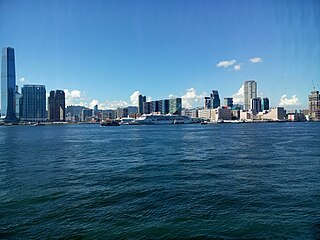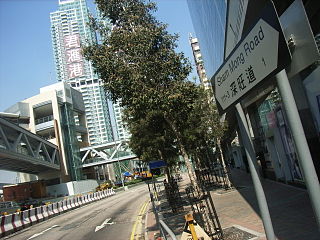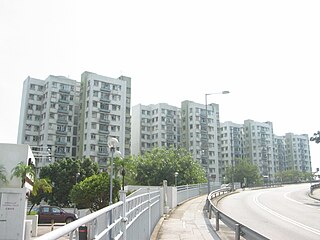
Kowloon is an urban area in Hong Kong comprising the Kowloon Peninsula and New Kowloon. It is bordered by the Lei Yue Mun strait to the east, Mei Foo Sun Chuen and Stonecutter's Island to the west, a mountain range, including Tate's Cairn and Lion Rock to the north, and Victoria Harbour to the south. With a population of 2,019,533 and a population density of 43,033/km2 in 2006, it is the most populous urban area in Hong Kong. The peninsula's area is approximately 47 km2 (18 sq mi).

Cheung Sha Wan is an underground station located underneath Cheung Sha Wan Road in Sham Shui Po District on the Tsuen Wan Line of Hong Kong MTR, between Sham Shui Po and Lai Chi Kok. It was opened in 1982. The station's livery is brass.
Castle Peak Road is the longest road in Hong Kong. Completed in 1933, it runs from Tai Po Road in Sham Shui Po, Kowloon to the very north of the New Territories, serving south, west and north New Territories, being one of the most distant roads in early Hong Kong.

Cheung Sha Wan is an area between Lai Chi Kok and Sham Shui Po in New Kowloon, Hong Kong. It is mainly residential to the north and south, with an industrial area in between. Administratively it is part of Sham Shui Po District which includes Lai Chi Kok as well.

Lai Chi Kok is a neighborhood in New Kowloon, Hong Kong, east of Kwai Chung and west of Cheung Sha Wan. Mei Foo Sun Chuen is the largest housing estate in the area and also the largest in the HKSAR with 99 blocks. Administratively, it belongs to the Sham Shui Po District.

West Kowloon Corridor is part of Route 5 in Hong Kong. Bypassing existing surface roads in West Kowloon, it connects Lai Chi Kok Road in Cheung Sha Wan with the Gascoigne Road Flyover near Yau Ma Tei.

Lai Chi Kok Road is a road in western New Kowloon, Hong Kong. It links Lai Chi Kok to Mong Kok, via Tai Kok Tsui, Sham Shui Po and Cheung Sha Wan. It starts from a junction with Nathan Road near Pioneer Centre in the south and ends near Mei Foo Sun Chuen. The road is bidirectional except the section at Lai Chi Kok, between the junction with Butterfly Valley Road and Mei Foo Sun Chuen, where it serves New Territories-bound traffic. The Kowloon-bound is left to Cheung Sha Wan Road, separated by the flyover of Kwai Chung Road.

Sham Shui Po Park is a park in Sham Shui Po, New Kowloon, Hong Kong. It comprises two physically discontiguous sites on either side of Lai Chi Kok Road. The larger site is more well-known as Sham Shui Po Park. The smaller, located within Lai Kok Estate and originally managed by the Housing Authority, became part of Sham Shui Po Park when it was transferred to the Leisure and Cultural Services Department.

Dragon Centre is a nine-storey shopping centre in the Sham Shui Po area of Kowloon, Hong Kong. It was the largest in West Kowloon until the Elements opened above the Kowloon MTR station.

Sham Mong Road is a major road on the new reclamation of the 1990s in western Kowloon and New Kowloon of Hong Kong.

Piper's Hill is a hill north of Cheung Sha Wan in Kowloon of Hong Kong. Administratively, it is on the border between Sham Shui Po District and Sha Tin District.

Manhattan Hill is a high-rise development located in the Lai Chi Kok district of Kowloon in Hong Kong, formerly Kowloon Motor Bus Lai Chi Kok Depot. The complex consists of five towers. Towers 1 and 2, which are interconnected, rise 51 floors, while towers 3, 5 and 6 rise 49 floors; each of the five towers is 198 metres (650 ft) high. The entire complex was developed by Sun Hung Kai Properties and was completed in January 2007.

Sham Shui Po Ferry Pier was a ferry pier in Sham Shui Po, Kowloon, Hong Kong that operated from 1924 to 1992. It was one of the important ferry piers in West Kowloon and had a bus terminus nearby.

The following is an overview of public housing estates in Kwai Chung, Hong Kong, including Home Ownership Scheme (HOS), Private Sector Participation Scheme (PSPS), Sandwich Class Housing Scheme (SCHS), Flat-for-Sale Scheme (FFSS), and Tenants Purchase Scheme (TPS) estates.

The following is an overview of public housing estates in Cheung Sha Wan, Hong Kong, including Home Ownership Scheme (HOS), Private Sector Participation Scheme (PSPS), and Tenants Purchase Scheme (TPS) estates.

The following is an overview of public housing estates in Sham Shui Po, Hong Kong, including Home Ownership Scheme (HOS), Private Sector Participation Scheme (PSPS), and Tenants Purchase Scheme (TPS) estates.

Ching Lai Court is a Home Ownership Scheme court in Lai Chi Kok, Kowloon, Hong Kong, located at the junction of Ching Cheung Road and Kwai Chung Road near Princess Margaret Hospital. Although it is situated at the south of Kwai Chung, it administratively belongs to Sham Shui Po District. It has totally 7 blocks and a shopping centre built in 1981.
























